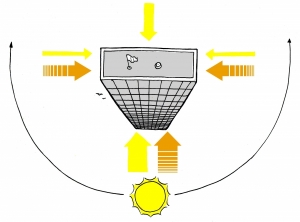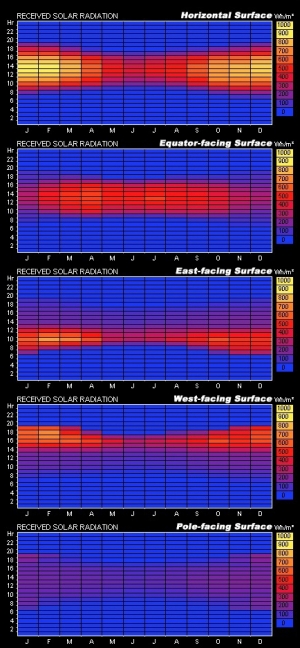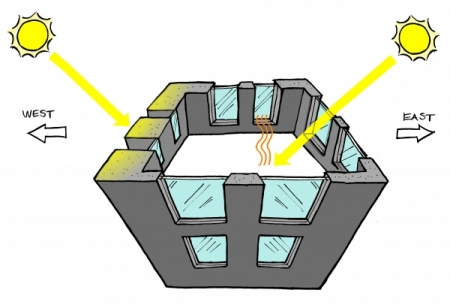You are here
Massing and orientation are important design factors to consider for passive heating. Massing and orientation for passive heating is often helped by extending the east-west axis of buildings to take advantage of the consistent sun on the northern and southern exposures.
Many strategies that are appropriate for daylighting are also effective for passive heating massing and orientation. However, thinner buildings may not be better. It depends on the climate and the program. Some distinctions of massing and orientation for passive heating are:
- First, the amount of sunlight that is optimal for daylighting is often not optimal for solar heat gain.
- Second, since the sun's heat does not come from all directions like the sun's light can, walls facing away from the sun's path get no heat gain, even though they can still get large amounts of diffuse light.
- Third, the sun's heat can be stored by thermal mass, which the sun's light cannot. This can be useful for west-facing walls to store heat for the night.
Massing Strategies for Passive Heating
In cold climates, massing that minimizes the ratio of surface area to volume (approaching a cube or hemisphere) can avoid unwanted heat loss. The sun's heat is advantageous, though, and more surface area facing it can help passively heat the building. The side of the building exposed to the sun's path can be increased while reducing the exposed areas of the other sides of the building.
In hot climates, thin buildings with their biggest face exposed to the sun can cause unwanted solar heat gain. Shading devices and good windows can be used to reduce this while still allowing natural ventilation. Taller buildings can also reduce unwanted gains in hot climates, as the sun's heat strikes more strongly on roofs than on walls in warm latitudes, and tall buildings have less roof area per unit volume.
It’s important to remember that the sun's heat does not come from all directions like the sun's light can. Walls facing the sun's path get the most light and the most heat. Windows facing away from the sun's path can still get large amounts of diffuse light, but without heat gain (and can have excessive heat loss). Windows facing east are warmed in the morning when it is often welcome to break the chill of night, but windows facing west are heated in the afternoon when spaces are generally already warm.
 |
|
Massing for solar heat gain (orange) can be different from massing for daylighting (yellow). |
Orientation Strategies for Passive Heating
Buildings that are longer than they are wide should usually be oriented east-west rather than north-south. This orientation lets you consistently harness thermal gain, or consistently avoid it, along the long face of the building. It also lets you minimize the area that’s subject to faster energy swings from the rising or setting sun. Solar heat gain on the east side can be acceptable or even useful, because it happens in the morning after the cooler night; but solar heat gain on the west side is rarely desirable at the end of an already warm day.
Before determining the materials for the façade, it’s important to understand the patterns of solar radiation that affect the building. The following image shows solar incident radiation throughout the day and throughout the year on the five exposed faces of a cube-shaped building. The vertical axis shows times of day while the horizontal axis shows times of year, and the color shows the amount of incident heat.
 |
|
Incident solar radiation on different faces of a building through time, in a mid-latitude |
The graph shows how thermal heat gain on the east and west sides of buildings change rapidly as the sun moves through the day, while northern and southern exposures are more consistent.
Calculating the Optimum Orientation
The below diagram shows optimum orientation angles for a building, based on solar radiation received in the coldest three months (blue), the warmest three months (red), and over the entire year (green).
 |
|
|
The most favorable orientations occur where the amount of incident radiation in winter is greater than the incident in summer, where the blue line extends out beyond the red line.
However, it is also desirable to provide as much protection from the maximum summer radiation as possible. The optimum orientation balances these. Thus, in the graph above, the compromise angle is not exactly at the point of maximum winter collection, but slightly to the east in order to "turn away" slightly from the hot afternoon sun in summer.
Material Choices for Orientation
Material choices and glazing are part of a building's orientation for passive. They can avoid unwanted solar heat gain, or unlike daylighting, they can store the sun's heat with thermal mass. An orientation that supplies just enough daylight may supply too much heat, or vice-versa.
Equator-facing sides of the building are well suited to capture and store the sun's heat via large windows and materials with high thermal mass, while sides facing away from the sun's path are not.
To even out temperature swings at sunrise and sunset, east sides may benefit from more window area for direct solar heat gain, while west sides may benefit from smaller window areas and high thermal mass to absorb the heat and release it through the night. The right strategy depends on the climate.
 |
More glazing to the east and more thermal mass to the west can even out temperature swings from the sun’s heat. |
In cold climates, sides facing away from the sun's path will usually benefit from more insulation than sides facing the sun (which means less glazing or higher-insulation glazing), while in hot climates the opposite is true.
Advanced glazing can separate the harvesting of the sun's light from the sun's heat. It can also pull in daylight from sides facing away from the sun, without losing too much heat through lack of insulation (low U-value).
